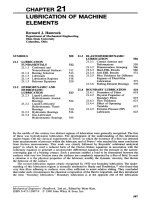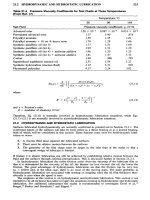The periodic table of the elements
Bạn đang xem bản rút gọn của tài liệu. Xem và tải ngay bản đầy đủ của tài liệu tại đây (4.51 MB, 684 trang )
A Periodic Table of the Elements at Los Alamos National Laboratory
Los Alamos National Laboratory's Chemistry Division Presents
Periodic Table of the Elements
A Resource for Elementary, Middle School, and High School Students
Click an element for more information:
Group**
Period
1
IA
1A
1
1
2
3
4
5
6
7
18
VIIIA
8A
1.008
2
IIA
2A
3
4
H
13 14 15 16 17
IIIA IVA VA VIA VIIA
3A 4A 5A 6A 7A
5
Li Be
6.941
9.012
11
12
Na Mg
22.99
24.31
19
20
6
7
8
9
2
He
4.003
10
B C N O F Ne
10.81 12.01 14.01 16.00 19.00 20.18
3
4 5
6
7
8
9 10 11 12
IIIB IVB VB VIB VIIB ------- VIII
IB IIB
3B 4B 5B 6B 7B
1B
2B
------------- 8 ------21
22
23
24
25
26
27
28
29
30
13
14
15
16
17
18
Al Si P S Cl Ar
26.98 28.09 30.97 32.07 35.45 39.95
31
32
33
34
35
36
K Ca Sc Ti V Cr Mn Fe Co Ni Cu Zn Ga Ge As Se Br Kr
39.10
40.08
37
38
Rb Sr
85.47
87.62
55
56
44.96 47.88 50.94 52.00 54.94 55.85 58.47 58.69 63.55 65.39 69.72 72.59 74.92 78.96 79.90 83.80
39
40
41
42
43
44
45
46
47
48
49
50
51
52
53
54
Y Zr Nb Mo Tc Ru Rh Pd Ag Cd In Sn Sb Te I Xe
88.91 91.22 92.91 95.94 (98)
57
72
73
74
75
101.1 102.9 106.4 107.9 112.4 114.8 118.7 121.8 127.6 126.9 131.3
76
77
78
79
80
81
82
83
84
85
86
Cs Ba La* Hf Ta W Re Os Ir Pt Au Hg Tl Pb Bi Po At Rn
132.9
137.3
87
88
138.9 178.5 180.9 183.9 186.2 190.2 190.2 195.1 197.0 200.5 204.4 207.2 209.0 (210) (210) (222)
112
114
116
118
Fr Ra Ac~ Rf Db Sg Bh Hs Mt --- --- ---
---
---
---
()
()
()
(223)
(226)
89
104 105
106
107
108
109
(227) (257) (260) (263) (262) (265) (266)
(1 of 3) [8/29/2001 6:07:19 PM]
110
()
111
()
()
A Periodic Table of the Elements at Los Alamos National Laboratory
58
Lanthanide Series*
59
60
61
62
63
64
65
66
67
68
69
70
71
Ce Pr Nd Pm Sm Eu Gd Tb Dy Ho Er Tm Yb Lu
140.1 140.9 144.2 (147) 150.4 152.0 157.3 158.9 162.5 164.9 167.3 168.9 173.0 175.0
90
Actinide Series~
91
92
93
94
95
96
97
98
99
100
101
102
103
Th Pa U Np Pu Am Cm Bk Cf Es Fm Md No Lr
232.0 (231) (238) (237) (242) (243) (247) (247) (249) (254) (253) (256) (254) (257)
** Groups are noted by 3 notation conventions.
For a list of a the element names and symbols in alphabetical order, click here
Download this Web Site to your computer (Adobe Acrobat format - PDF)
Get Adobe Acrobat Reader for free
Questions - Comments - Feedback
Send an email to
What is the Periodic Table?
How to use the Periodic Table
Click here to see Mendeleev's original Periodic
Table
Chemistry in a Nutshell
Naming New Elements
LANL | DOE | Disclaimer ]
Last Updated: 5/10/2001
about this resource
(2 of 3) [8/29/2001 6:07:19 PM]
A Periodic Table of the Elements at Los Alamos National Laboratory
(3 of 3) [8/29/2001 6:07:19 PM]
Hydrogen
Hydrogen
For rocket fuel
Atomic Number:
1
Atomic Symbol:
H
Atomic Weight:
1.0079
Electron Configuration: 1s1
History
(Gr. hydro, water, and genes, forming) Hydrogen was prepared many years before it was recognized as a
distinct substance by Cavendish in 1776.
Named by Lavoisier, hydrogen is the most abundant of all elements in the universe. The heavier elements
were originally made from Hydrogen or from other elements that were originally made from Hydrogen.
Sources
Hydrogen is estimated to make up more than 90% of all the atoms or three quarters of the mass of the
universe. This element is found in the stars, and plays an important part in powering the universe through
both the proton-proton reaction and carbon-nitrogen cycle -- stellar hydrogen fusion processes that
release massive amounts of energy by combining Hydrogen to form Helium.
Production of hydrogen in the U.S. alone now amounts to about 3 billion cubic feet per year. Hydrogen is
prepared by
● steam on heated carbon,
● decomposition of certain hydrocarbons with heat,
● action of sodium or potassium hydroxide on aluminum
● electrolysis of water, or
● displacement from acids by certain metals.
Liquid hydrogen is important in cryogenics and in the study of superconductivity, as its melting point is
only 20 degrees above absolute zero.
Tritium is readily produced in nuclear reactors and is used in the production of the hydrogen bomb.
Hydrogen is the primary component of Jupiter and the other gas giant planets. At some depth in the
planet's interior the pressure is so great that solid molecular hydrogen is converted to solid metallic
(1 of 3) [8/29/2001 6:07:20 PM]
Hydrogen
hydrogen.
In 1973, a group of Russian experimenters may have produced metallic hydrogen at a pressure of 2.8
Mbar. At the transition the density changed from 1.08 to 1.3 g/cm3. Earlier, in 1972, at Livermore,
California, a group also reported on a similar experiment in which they observed a pressure-volume
point centered at 2 Mbar. Predictions say that metallic hydrogen may be metastable; others have
predicted it would be a superconductor at room temperature.
Compounds
Although pure Hydrogen is a gas we find very little of it in our atmosphere. Hydrogen gas is so light
that uncombined Hydrogen will gain enough velocity from collisions with other gases that they will
quickly be ejected from the atmosphere. On earth, hydrogen occurs chiefly in combination with oxygen
in water, but it is also present in organic matter such as living plants, petroleum, coal, etc. It is present as
the free element in the atmosphere, but only to the extent of less than 1 ppm by volume. The lightest of
all gases, hydrogen combines with other elements -- sometimes explosively -- to form compounds.
Uses
Great quantities are required commercially for the fixation of nitrogen from the air in the Haber ammonia
process and for the hydrogenation of fats and oils. It is also used in large quantities in methanol
production, in hydrodealkylation, hydrocracking, and hydrodesulfurization. Other uses include rocket
fuel, welding, producing hydrochloric acid, reducing metallic ores, and filling balloons.
The lifting power of 1 cubic foot of hydrogen gas is about 0.07 lb at 0C, 760 mm pressure.
The Hydrogen Fuel cell is a developing technology that will allow great amounts of electrical power to
be obtained using a source of hyrogen gas.
Consideration is being given to an entire economy based on solar- and nuclear-generated hydrogen.
Public acceptance, high capital investment, and the high cost of hydrogen with respect to today's fuels are
but a few of the problems facing such an economy. Located in remote regions, power plants would
electrolyze seawater; the hydrogen produced would travel to distant cities by pipelines. Pollution-free
hydrogen could replace natural gas, gasoline, etc., and could serve as a reducing agent in metallurgy,
chemical processing, refining, etc. It could also be used to convert trash into methane and ethylene.
Forms
Quite apart from isotopes, it has been shown that under ordinary conditions hydrogen gas is a mixture of
two kinds of molecules, known as ortho- and para-hydrogen, which differ from one another by the spins
of their electrons and nuclei.
Normal hydrogen at room temperature contains 25% of the para form and 75% of the ortho form. The
ortho form cannot be prepared in the pure state. Since the two forms differ in energy, the physical
properties also differ. The melting and boiling points of parahydrogen are about 0.1oC lower than those
of normal hydrogen.
(2 of 3) [8/29/2001 6:07:20 PM]
Hydrogen
Isotopes
The ordinary isotope of hydrogen, H, is known as Protium, the other two isotopes are Deuterium (a
proton and a neutron) and Tritium (a protron and two neutrons). Hydrogen is the only element whose
isotopes have been given different names. Deuterium and Tritium are both used as fuel in nuclear fusion
reactors. One atom of Deuterium is found in about 6000 ordinary hydrogen atoms.
Deuterium is used as a moderator to slow down neutrons. Tritium atoms are also present but in much
smaller proportions. Tritium is readily produced in nuclear reactors and is used in the production of the
hydrogen (fusion) bomb. It is also used as a radioactive agent in making luminous paints, and as a tracer.
Sources: CRC Handbook of Chemistry and Physics and the American Chemical Society.
Last Updated: 12/19/97, CST Information Services Team
(3 of 3) [8/29/2001 6:07:20 PM]
Helium
Helium
For blimps
Atomic Number:
2
Atomic Symbol:
He
Atomic Weight:
4.00260
Electron Configuration: 1s2
History
(Gr. helios, the sun). Janssen obtained the first evidence of helium during the solar eclipse of 1868 when
he detected a new line in the solar spectrum. Lockyer and Frankland suggested the name helium for the
new element. In 1895 Ramsay discovered helium in the uranium mineral clevite while it was
independently discovered in cleveite by the Swedish chemists Cleve and Langlet at about the same time.
Rutherford and Royds in 1907 demonstrated that alpha particles are helium nuclei.
Sources
Except for hydrogen, helium is the most abundant element found through out the universe. Helium is
extracted from natural gas. In fact, all natural gas contains at least trace quantities of helium.
It has been detected spectroscopically in great abundance, especially in the hotter stars, and it is an
important component in both the proton-proton reaction and the carbon cycle, which account for the
energy of the sun and stars.
The fusion of hydrogen into helium provides the energy of the hydrogen bomb. The helium content of
the atmosphere is about 1 part in 200,000. While it is present in various radioactive minerals as a decay
product, the bulk of the Free World's supply is obtained from wells in Texas, Oklahoma, and Kansas.
The only known helium extraction plants, outside the United States, in 1984 were in Eastern Europe
(Poland), the USSR, and a few in India.
Cost
The cost of helium fell from $2500/ft3 in 1915 to 1.5 cents /ft3 in 1940. The U.S. Bureau of Mines has set
the price of Grade A helium at $37.50/1000 ft3 in 1986.
(1 of 3) [8/29/2001 6:07:20 PM]
Helium
Properties
Helium has the lowest melting point of any element and is widely used in cryogenic research because its
boiling point is close to absolute zero. Also, the element is vital in the study of super conductivity.
Using liquid helium, Kurti and co-workers and others, have succeeded in obtaining temperatures of a few
microkelvins by the adiabatic demagnetization of copper nuclei.
It has other peculiar properties. Helium is the only liquid that cannot be solidified by lowering the
temperature. It remains liquid down to absolute zero at ordinary pressures, but it can readily be solidified
by increasing the pressure. Solid 3He and 4He are unusual in that both can be changed in volume by
more than 30% by applying pressure.
The specific heat of helium gas is unusually high. The density of helium vapor at the normal boiling
point is also very high, with the vapor expanding greatly when heated to room temperature. Containers
filled with helium gas at 5 to 10 K should be treated as though they contained liquid helium due to the
large increase in pressure resulting from warming the gas to room temperature.
While helium normally has a 0 valence, it seems to have a weak tendency to combine with certain other
elements. Means of preparing helium difluoride have been studied, and species such as HeNe and the
molecular ions He+ and He++ have been investigated.
Isotopes
Seven isotopes of helium are known: Liquid helium (He4) exists in two forms: He4I and He4II, with a
sharp transition point at 2.174K. He4I (above this temperature) is a normal liquid, but He4II (below it) is
unlike any other known substance. It expands on cooling; its conductivity for heat is enormous; and
neither its heat conduction nor viscosity obeys normal rules.
Uses
●
●
●
●
as an inert gas shield for arc welding;
a protective gas in growing silicon and germanium crystals and producing titanium and zirconium;
as a cooling medium for nuclear reactors, and
as a gas for supersonic wind tunnels.
A mixture of helium and oxygen is used as an artificial atmosphere for divers and others working under
pressure. Different ratios of He/O2 are used for different depths at which the diver is operating.
Helium is extensively used for filling balloons as it is a much safer gas than hydrogen. One of the recent
largest uses for helium has been for pressuring liquid fuel rockets. A Saturn booster, like the type used on
the Apollo lunar missions, required about 13 million ft3 of helium for a firing, plus more for checkouts.
Liquid helium's use in magnetic resonance imaging (MRI) continues to increase as the medical
profession accepts and develops new uses for the equipment. This equipment has eliminated some need
for exploratory surgery by accurately diagnosing patients. Another medical application uses MRE to
(2 of 3) [8/29/2001 6:07:20 PM]
Helium
determine (by blood analysis) whether a patient has any form of cancer.
Helium is also being used to advertise on blimps for various companies, including Goodyear. Other
lifting gas applications are being developed by the Navy and Air Force to detect low-flying cruise
missiles. Additionally, the Drug Enforcement Agency is using radar-equipped blimps to detect drug
smugglers along the United States boarders. In addition, NASA is currently using helium-filled balloons
to sample the atmosphere in Antarctica to determine what is depleting the ozone layer.
Costs
Materials which become super conductive at higher temperatures than the boiling point of helium could
have a major impact on the demand for helium. These less costly refrigerant materials could replace the
present need to cool superconductive materials to the boiling point of helium.
Sources: CRC Handbook of Chemistry and Physics and the American Chemical Society.
Last Updated: 12/19/97, CST Information Services Team
(3 of 3) [8/29/2001 6:07:20 PM]
Lithium
Lithium
For pacemaker batteries
Atomic Number:
3
Atomic Symbol:
Li
Atomic Weight:
6.941
Electron Configuration: [He]2s1
History
(Gr. lithos, stone) Discovered by Arfvedson in 1817. Lithium is the lightest of all metals, with a density
only about half that of water.
Sources
It does not occur free in nature; combined it is found in small units in nearly all igneous rocks and in the
waters of many mineral springs. Lepidolite, spodumeme, petalite, and amblygonite are the more
important minerals containing it.
Lithium is presently being recovered from brines of Searles Lake, in California, and from those in
Nevada. Large deposits of quadramene are found in North Carolina. The metal is produced
electrolytically from the fused chloride. Lithium is silvery in appearance, much like Na and K, other
members of the alkali metal series. It reacts with water, but not as vigorously as sodium. Lithium imparts
a beautiful crimson color to a flame, but when the metal burns strongly, the flame is a dazzling white.
Uses
Since World War II, the production of lithium metal and its compounds has increased greatly. Because
the metal has the highest specific heat of any solid element, it has found use in heat transfer applications;
however, it is corrosive and requires special handling. The metal has been used as an alloying agent, is of
interest in synthesis of organic compounds, and has nuclear applications. It ranks as a leading contender
as a battery anode material as it has a high electrochemical potential. Lithium is used in special glasses
and ceramics. The glass for the 200-inch telescope at Mt. Palomar contains lithium as a minor ingredient.
Lithium chloride is one of the most lyproscopic materials known, and it, as well as lithium bromide, is
used in air conditioning and industrial drying systems. Lithium stearate is used as an all-purpose and
high-temperature lubricant. Other lithium compounds are used in dry cells and storage batteries.
(1 of 2) [8/29/2001 6:07:20 PM]
Lithium
Cost
The metal is priced at about $300/lb.
Sources: CRC Handbook of Chemistry and Physics and the American Chemical Society.
Last Updated: 12/19/97, CST Information Services Team
(2 of 2) [8/29/2001 6:07:20 PM]
Beryllium
Beryllium
For watch springs
Atomic Number:
4
Atomic Symbol:
Be
Atomic Weight:
9.01218
Electron Configuration: [He]2s2
History
(Gr. beryllos, beryl; also called Glucinium or Glucinum, Gr. glykys, sweet) Discovered as the oxide by
Vauquelin in beryl and in emeralds in 1798. The metal was isolated in 1828 by Wohler and by Bussy
independently by the action of potassium on beryllium chloride.
Sources
Beryllium is found in some 30 mineral species, the most important of which are bertrandite, beryl,
chrysoberyl, and phenacite. Aquamarine and emerald are precious forms of beryl. Beryl and bertrandite
are the most important commercial sources of the element and its compounds. Most of the metal is now
prepared by reducing beryllium fluoride with magnesium metal. Beryllium metal did not become readily
available to industry until 1957.
Properties
The metal, steel gray in color, has many desirable properties. As one of the lightest of all metals, it has
one of the highest melting points of the light metals. Its modulus of elasticity is about one third greater
than that of steel. It resists attack by concentrated nitric acid, has excellent thermal conductivity, and is
nonmagnetic. It has a high permeability to X-rays and when bombarded by alpha particles, as from
radium or polonium, neutrons are produced in the amount of about 30 neutrons/million alpha particles.
At ordinary temperatures, beryllium resists oxidation in air, although its ability to scratch glass is
probably due to the formation of a thin layer of the oxide.
(1 of 2) [8/29/2001 6:07:21 PM]
Beryllium
Uses
Beryllium is used as an alloying agent in producing beryllium copper, which is extensively used for
springs, electrical contacts, spot-welding electrodes, and non-sparking tools. It is applied as a structural
material for high-speed aircraft, missiles, spacecraft, and communication satellites. Other uses include
windshield frame, brake discs, support beams, and other structural components of the space shuttle.
Because beryllium is relatively transparent to X-rays, ultra-thin Be-foil is finding use in X-ray
lithography for reproduction of micro-miniature integrated circuits.
Beryllium is used in nuclear reactors as a reflector or moderator for it has a low thermal neutron
absorption cross section.
It is used in gyroscopes, computer parts, and instruments where lightness, stiffness, and dimensional
stability are required. The oxide has a very high melting point and is also used in nuclear work and
ceramic applications.
Handling
Beryllium and its salts are toxic and should be handled with the greatest of care. Beryllium and its
compounds should not be tasted to verify the sweetish nature of beryllium (as did early experimenters).
The metal, its alloys, and its salts can be handled if certain work codes are observed, but no attempt
should be made to work with beryllium before becoming familiar with proper safeguards.
Sources: CRC Handbook of Chemistry and Physics and the American Chemical Society.
Last Updated: 12/19/97, CST Information Services Team
(2 of 2) [8/29/2001 6:07:21 PM]
Boron
Boron
For tennis rackets
Atomic Number:
5
Atomic Symbol:
B
Atomic Weight:
10.81
Electron Configuration: [He]2s22p1
History
(Ar. Buraq, Pers. Burah) Boron compounds have been known for thousands of years, but the element was
not discovered until 1808 by Sir Humphry Davy and by Gay-Lussac and Thenard.
Sources
The element is not found free in nature, but occurs as orthoboric acid usually found in certain volcanic
spring waters and as borates in boron and colemantie. Ulexite, another boron mineral, is interesting as it
is nature's own version of "fiber optics."
Important sources of boron are ore rasorite (kernite) and tincal (borax ore). Both of these ores are found
in the Mojave Desert. Tincal is the most important source of boron from the Mojave. Extensive borax
deposits are also found in Turkey.
Boron exists naturally as 19.78% 10B isotope and 80.22% 11B isotope. High-purity crystalline boron
may be prepared by the vapor phase reduction of boron trichloride or tribromide with hydrogen on
electrically heated filaments. The impure or amorphous, boron, a brownish-black powder, can be
obtained by heating the trioxide with magnesium powder.
Boron of 99.9999% purity has been produced and is available commercially. Elemental boron has an
energy band gap of 1.50 to 1.56 eV, which is higher than that of either silicon or germanium.
Properties
Optical characteristics include transmitting portions of the infrared. Boron is a poor conductor of
electricity at room temperature but a good conductor at high temperature.
(1 of 2) [8/29/2001 6:07:21 PM]
Boron
Uses
Amorphous boron is used in pyrotechnic flares to provide a distinctive green color, and in rockets as an
igniter.
By far the most commercially important boron compound in terms of dollar sales is Na2B4O7.5H2O. This
pentahydrate is used in very large quantities in the manufacture of insulation fiberglass and sodium
perborate bleach.
Boric acid is also an important boron compound with major markets in textile products. Use of borax as a
mild antiseptic is minor in terms of dollars and tons. Boron compounds are also extensively used in the
manufacture of borosilicate glasses. Other boron compounds show promise in treating arthritis.
The isotope boron-10 is used as a control for nuclear reactors, as a shield for nuclear radiation, and in
instruments used for detecting neutrons. Boron nitride has remarkable properties and can be used to make
a material as hard as diamond. The nitride also behaves like an electrical insulator but conducts heat like
a metal.
It also has lubricating properties similar to graphite. The hydrides are easily oxidized with considerable
energy liberation, and have been studied for use as rocket fuels. Demand is increasing for boron
filaments, a high-strength, lightweight material chiefly employed for advanced aerospace structures.
Boron is similar to carbon in that it has a capacity to form stable covalently bonded molecular networks.
Carbonates, metalloboranes, phosphacarboranes, and other families comprise thousands of compounds.
Costs
Crystalline boron (99%) costs about $5/g. Amorphous boron costs about $2/g.
Handling
Elemental boron and the borates are not considered to be toxic, and they do not require special care in
handling. However, some of the more exotic boron hydrogen compounds are definitely toxic and do
require care.
Sources: CRC Handbook of Chemistry and Physics and the American Chemical Society.
Last Updated: 12/19/97, CST Information Services Team
(2 of 2) [8/29/2001 6:07:21 PM]
Carbon
Carbon
For pencils
Atomic Number:
6
Atomic Symbol:
C
Atomic Weight:
12.011
Electron Configuration: [He]2s22p2
History
(Latin: carbo, charcoal) Carbon, an element of prehistoric discovery, is very widely distributed in nature.
It is found in abundance in the sun, stars, comets, and atmospheres of most planets. Carbon in the form of
microscopic diamonds is found in some meteorites.
Natural diamonds are found in kimberlite of ancient volcanic "pipes," found in South Africa, Arkansas,
and elsewhere. Diamonds are now also being recovered from the ocean floor off the Cape of Good Hope.
About 30% of all industrial diamonds used in the U.S. are now made synthetically.
The energy of the sun and stars can be attributed at least in part to the well-known carbon-nitrogen cycle.
Forms
Carbon is found free in nature in three allotropic forms: amorphous, graphite, and diamond. A fourth
form, known as "white" carbon, is now thought to exist. Ceraphite is one of the softest known materials
while diamond is one of the hardest.
Graphite exists in two forms: alpha and beta. These have identical physical properties, except for their
crystal structure. Naturally occurring graphites are reported to contain as much as 30% of the
rhombohedral (beta) form, whereas synthetic materials contain only the alpha form. The hexagonal alpha
type can be converted to the beta by mechanical treatment, and the beta form reverts to the alpha on
heating it above 1000oC.
In 1969 a new allotropic form of carbon was produced during the sublimation of pyrolytic graphite at
low pressures. Under free-vaporization conditions above ~2550oK, "white" carbon forms as small
transparent crystals on the edges of the planes of graphite. The interplanar spacings of "white" carbon are
identical to those of carbon form noted in the graphite gneiss from the Ries (meteroritic) Crater of
Germany. "White" carbon is a transparent birefringent material. Little information is presently available
about this allotrope.
(1 of 2) [8/29/2001 6:07:21 PM]
Carbon
Compounds
In combination, carbon is found as carbon dioxide in the atmosphere of the earth and dissolved in all
natural waters. It is a component of great rock masses in the form of carbonates of calcium (limestone),
magnesium, and iron. Coal, petroleum, and natural gas are chiefly hydrocarbons.
Carbon is unique among the elements in the vast number and variety of compounds it can form. With
hydrogen, oxygen, nitrogen, and other elements, it forms a very large number of compounds, carbon
atom often being linked to carbon atom. There are close to ten million known carbon compounds, many
thousands of which are vital to organic and life processes.
Without carbon, the basis for life would be impossible. While it has been thought that silicon might take
the place of carbon in forming a host of similar compounds, it is now not possible to form stable
compounds with very long chains of silicon atoms. The atmosphere of Mars contains 96.2% CO2. Some
of the most important compounds of carbon are carbon dioxide (CO2), carbon monoxide (CO), carbon
disulfide (CS2), chloroform (CHCl3), carbon tetrachloride (CCl4), methane (CH4), ethylene (C2H4),
acetylene (C2H2), benzene (C6H6), acetic acid (CH3COOH), and their derivatives.
Isotopes
Carbon has seven isotopes. In 1961 the International Union of Pure and Applied Chemistry adopted the
isotope carbon-12 as the basis for atomic weights. Carbon-14, an isotope with a half-life of 5715 years,
has been widely used to date such materials as wood, archaeological specimens, etc.
Costs
As of 1990 carbon-13 was commercially available at a cost of about $700/g.
Sources: CRC Handbook of Chemistry and Physics and the American Chemical Society.
Last Updated: 12/19/97, CST Information Services Team
(2 of 2) [8/29/2001 6:07:21 PM]
Nitrogen
Nitrogen
Nitrogen compounds for rocket fuels.
Atomic Number:
7
Atomic Symbol:
N
Atomic Weight:
14.00674
Electron Configuration: [He]2s22p3
History
(L. nitrum, Gr. Nitron, native soda; genes, forming) Nitrogen was discovered by
chemist and physician Daniel Rutherford in 1772. He removed oxygen and
carbon dioxide from air and showed that the residual gas would not support
combustion or living organisms. At the same time there were other noted
scientists working on the problem of nitrogen. These included Scheele,
Cavendish, Priestley, and others. They called it “burnt or dephlogisticated air,”
which meant air without oxygen.
Sources
Nitrogen gas (N2) makes up 78.1% of the Earth’s air, by volume. The atmosphere
of Mars, by comparison, is only 2.6% nitrogen. From an exhaustible source in our
atmosphere, nitrogen gas can be obtained by liquefaction and fractional
distillation. Nitrogen is found in all living systems as part of the makeup of
biological compounds.
(1 of 3) [8/29/2001 6:07:21 PM]
Nitrogen
The Element
The French chemist Antoine Laurent Lavoisier named nitrogen azote, meaning
without life. However, nitrogen compounds are found in foods, fertilizers,
poisons, and explosives. Nitrogen, as a gas is colorless, odorless, and generally
considered an inert element. As a liquid (boiling point = minus 195.8oC), it is also
colorless and odorless, and is similar in appearance to water. Nitrogen gas can be
prepared by heating a water solution of ammonium nitrite (NH4NO3).
Nitrogen Compounds and Nitrogen in Nature
Sodium nitrate (NaNO3) and potassium nitrate (KNO3) are formed by the
decomposition of organic matter with compounds of these metals present. In
certain dry areas of the world these saltpeters are found in quantity and are used
as fertilizers. Other inorganic nitrogen compounds are nitric acid (HNO3),
ammonia (NH3), the oxides (NO, NO2, N2O4, N2O), cyanides (CN-), etc.
The nitrogen cycle is one of the most important processes in nature for living
organisms. Although nitrogen gas is relatively inert, bacteria in the soil are
capable of “fixing” the nitrogen into a usable form (as a fertilizer) for plants. In
other words, Nature has provided a method to produce nitrogen for plants to
grow. Animals eat the plant material where the nitrogen has been incorporated
into their system, primarily as protein. The cycle is completed when other
bacterial convert the waste nitrogen compounds back to nitrogen gas. Nitrogen
has become crucial to life being a component of all proteins.
(2 of 3) [8/29/2001 6:07:21 PM]
Nitrogen
Ammonia
Ammonia (NH3) is the most important commercial compound of nitrogen. It is
produced by the Haber Process. Natural gas (methane, CH4) is reacted with steam
to produce carbon dioxide and hydrogen gas (H2) in a two step process.
Hydrogen gas and nitrogen gas are then reacted in the Haber Process to produce
ammonia. This colorless gas with a pungent odor is easily liquefied. In fact, the
liquid is used as a nitrogen fertilizer. Ammonia is also used in the production of
urea, NH2CONH2, which is used as a fertilizer, in the plastic industry, and in the
livestock industry as a feed supplement. Ammonia is often the starting compound
for many other nitrogen compounds.
Sources: CRC Handbook of Chemistry and Physics and the American Chemical Society.
Last Updated: 12/19/97, CST Information Services Team
(3 of 3) [8/29/2001 6:07:21 PM]
Oxygen
Oxygen
For combustion
Atomic Number:
8
Atomic Symbol:
O
Atomic Weight:
15.9994
Electron Configuration: [He]2s22p4
History
(Gr. oxys, sharp, acid, and genes, forming; acid former) For many centuries, workers occasionally
realized air was composed of more than one component. The behavior of oxygen and nitrogen as
components of air led to the advancement of the phlogiston theory of combustion, which captured the
minds of chemists for a century. Oxygen was prepared by several workers, including Bayen and Borch,
but they did not know how to collect it, did not study its properties, and did not recognize it as an
elementary substance.
Priestley is generally credited with its discovery, although Scheele also discovered it independently.
Its atomic weight was used as a standard of comparison for each of the other elements until 1961 when
the International Union of Pure and Applied Chemistry adopted carbon 12 as the new basis.
Sources
Oxygen is the third most abundant element found in the sun, and it plays a part in the carbon-nitrogen
cycle, the process once thought to give the sun and stars their energy. Oxygen under excited conditions is
responsible for the bright red and yellow-green colors of the Aurora.
A gaseous element, oxygen forms 21% of the atmosphere by volume and is obtained by liquefaction and
fractional distillation. The atmosphere of Mars contains about 0.15% oxygen. The element and its
compounds make up 49.2%, by weight, of the earth's crust. About two thirds of the human body and nine
tenths of water is oxygen.
In the laboratory it can be prepared by the electrolysis of water or by heating potassium chlorate with
manganese dioxide as a catalyst.
(1 of 3) [8/29/2001 6:07:21 PM]
Oxygen
Properties
The gas is colorless, odorless, and tasteless. The liquid and solid forms are a pale blue color and are
strongly paramagnetic.
Forms
Ozone (O3), a highly active compound, is formed by the action of an electrical discharge or ultraviolet
light on oxygen.
Ozone's presence in the atmosphere (amounting to the equivalent of a layer 3 mm thick under ordinary
pressures and temperatures) helps prevent harmful ultraviolet rays of the sun from reaching the earth's
surface. Pollutants in the atmosphere may have a detrimental effect on this ozone layer. Ozone is toxic
and exposure should not exceed 0.2 mg/m# (8-hour time-weighted average - 40-hour work week).
Undiluted ozone has a bluish color. Liquid ozone is bluish black and solid ozone is violet-black.
Compounds
Oxygen, which is very reactive, is a component of hundreds of thousands of organic compounds and
combines with most elements.
Uses
Plants and animals rely on oxygen for respiration. Hospitals frequently prescribe oxygen for patients with
respiratory ailments.
Isotopes
Oxygen has nine isotopes. Natural oxygen is a mixture of three isotopes.
Natural occurring oxygen 18 is stable and available commercially, as is water (H2O with 15% 18O).
Commercial oxygen consumption in the U.S. is estimated at 20 million short tons per year and the
demand is expected to increase substantially.
Oxygen enrichment of steel blast furnaces accounts for the greatest use of the gas. Large quantities are
also used in making synthesis gas for ammonia and methanol, ethylene oxide, and for oxy-acetylene
welding.
Air separation plants produce about 99% of the gas, while electrolysis plants produce about 1%.
(2 of 3) [8/29/2001 6:07:21 PM]
Oxygen
Costs
The gas costs 5 cents / ft3 in small quantities, and about $15/ton in large quantities.
Sources: CRC Handbook of Chemistry and Physics and the American Chemical Society.
Last Updated: 12/19/97, CST Information Services Team
(3 of 3) [8/29/2001 6:07:21 PM]
Fluorine
Fluorine
For toothpaste
Atomic Number:
9
Atomic Symbol:
F
Atomic Weight:
18.998403
Electron Configuration: [He]2s22p5
History
(L. and F. fluere, flow or flux) In 1529, Georigius Agricola described the use of fluorspar as a flux, and
as early as 1670 Schwandhard found that glass was etched when exposed to fluorspar treated with acid.
Scheele and many later investigators, including Davy, Gay-Lussac, Lavoisier, and Thenard,
experimented with hydrofluoric acid, some experiments ending in tragedy.
The element was finally isolated in 1866 by Moissan after nearly 74 years of continuous effort.
Properties
Fluorine is the most electronegative and reactive of all elements. It is a pale yellow, corrosive gas, which
reacts with most organic and inorganic substances. Finely divided metals, glass, ceramics, carbon, and
even water burn in fluorine with a bright flame.
Until World War II, there was no commercial production of elemental fluorine. The nuclear bomb
project and nuclear energy applications, however, made it necessary to produce large quantities.
Uses
Fluorine and its compounds are used in producing uranium (from the hexafluoride) and more than 100
commercial fluorochemicals, including many well known high-temperature plastics. Hydrofluoric acid
etches the glass of light bulbs, etc. Fluorochlorohydrocarbons are extensively used in air conditioning
and refrigeration.
The presence of fluorine as a soluble fluoride in drinking water to the extent of 2 ppm may cause mottled
enamel in teeth, when used by children acquiring permanent teeth; in smaller amounts, however,
fluorides are added to water supplies to prevent dental cavities.
Elemental fluorine has been studied as a rocket propellant as it has an exceptionally high specific impulse
(1 of 2) [8/29/2001 6:07:22 PM]
Fluorine
value.
Compounds
One hypothesis says that fluorine can be substituted for hydrogen wherever it occurs in organic
compounds, which could lead to an astronomical number of new fluorine compounds. Compounds of
fluorine with rare gases have now been confirmed in fluorides of xenon, radon, and krypton.
Handling
Elemental fluorine and the fluoride ion are highly toxic. The free element has a characteristic pungent
odor, detectable in concentrations as low as 20 ppb, which is below the safe working level. The
recommended maximum allowable concentration for a daily 8-hour time-weighted exposure is 1 ppm.
Safe handling techniques enable the transport liquid fluorine by the ton.
Sources: CRC Handbook of Chemistry and Physics and the American Chemical Society.
Last Updated: 12/19/97, CST Information Services Team
(2 of 2) [8/29/2001 6:07:22 PM]









